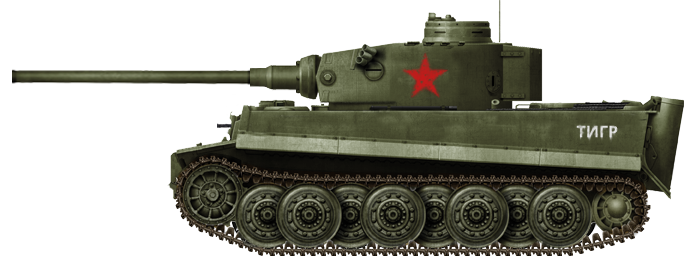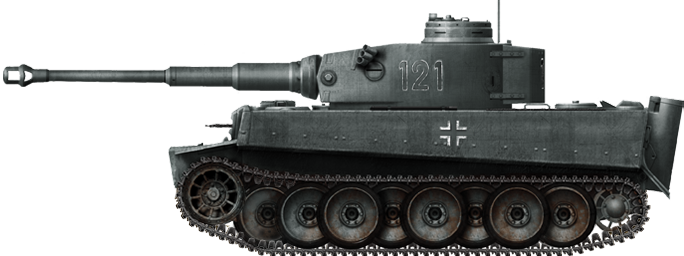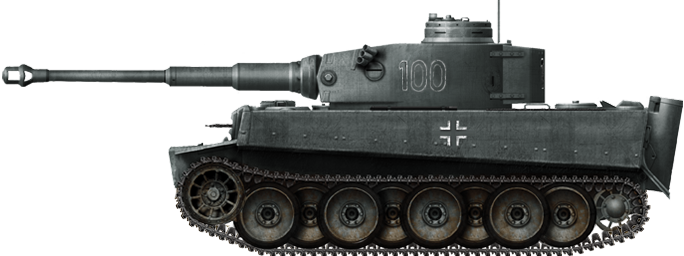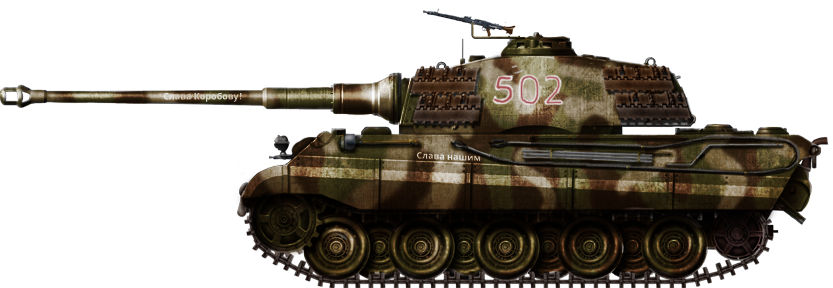 Soviet Union (1944-1945)
Soviet Union (1944-1945)
Heavy Tank – None Built
The Panzerkampfwagen VI “Tiger” Ausführung E is one of the most outstanding and iconic vehicles in the history of tank building. The Tiger caused significant problems for the Allies when it first appeared at the front. Fortunately for the Allies, shortly after, several vehicles were captured by the Red Army and tested. In the Soviet Union, designers even worked on the option of re-equipping this German heavy tank with ‘domestic’ Soviet guns. However, this project appeared too late, and the imminent end of the war did not give this proposal any chance to materialize.
The Heavy Cat of the Wehrmacht
The Tiger I, or ‘Panzerkampfwagen Tiger Ausführung E’ (Pz.Kpfw.Tiger Ausf.E), was born in May 1942, but its conception and development can be traced directly back to 1936 and 1937, with work on a 30-33 tonne tank by the firm of Henschel und Sohn in Kassel. Just like other German tank projects, the development was very complex, overlapping with dozens of other projects, and has been the subject of a large number of books and movies. The name ‘Tiger’ itself has a no less complex history. It was first used in February 1942, when the project “Pz.Kpfw.VI (VK45.01/H) Ausf.H1 (Tiger)” was approved. The design was clearly identified as the Pz.Kpfw.VI or Tiger, with “Tiger I” first used on 15th October 1942, followed by “Pz.Kpfw.VI H Ausf.H1 (Tiger H1)” on 1st December 1942 and then “Panzerkampfwagen Tiger Ausf.E” in March 1943.

Source: Zinoviy Alexeev Design Bureau, drawn by Andrej Sinyukovich.
The Tiger I had a crew of five: commander (back left), gunner (front left), and loader (right) in the turret, and the driver and radio operator in the front left and right of the hull, respectively.
The main armament consisted of the 8.8 cm Kw.K. 36 L/56 gun in the turret. This gun was derived from the 8.8 cm Flak 18 and Flak 36 AA guns and delivered similar ballistic performance. It was combined with the excellent T.Z.F.9b 2.5 x magnification binocular telescope for the gunner. This T.Z.F.9b binocular sight was later replaced by the cheaper but no less effective T.Z.F.9c monocular sight, a change identifiable by the switch to a single hole in the left side of the mantlet. The Tiger carried 92 rounds of Armor-Piercing (AP) and High Explosive (HE) ammunition. Where available, the Pz.Gr.40 (high velocity, sub-caliber, tungsten core, with no explosive filler) round was also carried for use against heavy enemy armor.
Secondary armament consisted of a 7.92 mm MG.34 machine gun mounted coaxially with the main gun. This weapon had a maximum elevation of -8º to +15º. A second machine gun, a ball-mounted MG.34, was located in the right-hand side of the driver’s plate. This second machine gun was capable of 15º traverse to either side (total arc of 30º) and an elevation of -7º to +20º. It was fitted with a K.Z.F.2 episcopic sighting telescope with a magnification of x1.75. For these machine guns, 4,500 rounds of ammunition were carried. Another M.G.34 anti-aircraft machine gun (Flieger-M.G.) could also be carried on the turret (also fitted to the Befehlswagen-Tiger).
After June 1942, six 95 mm diameter smoke grenade launchers (in two sets of three) were approved for mounting on the turret, a process which started in August 1942. The launchers could fire the Nb.K.39 90 mm smoke generator grenades but, following combat reports of gunfire setting them off and blinding the crews, these were dropped in June 1943.

The Tiger was powered in the early production runs by the HL 210 TRM P45 21-liter V-12 Maybach petrol engine producing 650 hp at 3,000 rpm. Due to problems with the reliability of this engine, the maximum performance could not be achieved, restricting mobility for this heavy tank. As a result of the poor performance, the more powerful HL 230 TRM P45 23 liter V-12 Maybach engine producing 700 hp was introduced in its place from May 1943 onwards.
The Tiger’s suspension consisted of 55 mm diameter torsion bars (Stabfedern), which ran the complete width of the tank’s hull, with splined heads, although the two front and rearmost two bars were wider than the rest, at 58 mm diameter. The bars were connected to the road wheel arms (Laufrad-Kurbel), each of which had three road wheels. Their arrangement overlapped wheels from adjacent road wheel-arms, creating an interleaved pattern to spread the load of the tank onto the track. Hydraulic shock absorbers were fitted to the inside of the front and rear road-wheel arms which, combined with the damping effect of the torsion bar, created a very smooth ride.
Unsuccessful Debut

On 29th August 1942, the first batch of Tigers from the 502nd Heavy Tank Battalion, consisting of four Pz.Kpfw. VI, advanced to combat positions from the railway station Mga, near Leningrad. Three vehicles suffered serious breakdowns leaving the station, and, in general, were not so successful. Later, during the battles to break the blockade of Leningrad, on 16th January 1943, Soviet troops captured a Tiger which was previously hit by artillery. This was followed by a practically intact one on 17th January. The crew left it without destroying even a brand-new technical passport, different tools, and weapons. Both tanks were evacuated from the combat area and sent to the Kubinka Proving Ground for studies.
Studying the «Wild Beast»

Initially, the captured tanks appeared in the correspondence as “captured tanks of the HENSHEL type”, later called T-VI. The tanks that arrived aroused great interest among the Soviet military command. By that time, the “Tigers” were actively used by the Germans both on the Soviet-German front and in North Africa. These vehicles were used for the first time on a truly massive scale during the battle for Kharkov, making a significant contribution to the defeat of the Red Army on this sector of the war front. Around the same time, the Tigers fought in Tunisia against American, British and Commonwealth troops, inflicting serious losses on them.
By April 1943, the two tanks, with turret numbers 100 and 121, were already at the proving ground. It was decided to test ‘121’ for armor durability and use ‘100’ for testing the gun against the armor of Soviet tanks.

The armor on the side of the Tiger’s hull managed to withstand the Soviet 45 mm guns. However, 57 mm guns of the ZiS-2 type overcame the 80 mm side armor with ease even from a long distance (up to 1 km). The frontal armor of the tank could not be penetrated by the 76 mm F-34 gun, the main Soviet tank gun at that time. The 85 mm “anti-aircraft gun” 52-K performed much better in this regard, penetrating the “Tiger” in the front from a distance of 1 km. The 122 mm A-19 gun performed the best at this. Until that moment, it had not yet been considered as a possible tank cannon. After two hits fired from it, the once formidable German heavy tank turned into a pile of scrap metal.

The tests of the German 88 mm tank gun were much more impressive. It was used to fire at Soviet T-34 and KV tanks. The main Soviet heavy tank of that time was easily penetrated from a distance of 1.5 km. Even the uparmored version with additional protection was also penetrated. For the T-34, the very first shot, from a distance of 1.5 km, “decapitated” the tank. Its turret was “knocked off” the hull, while significant damage to the frontal part of the hull was caused by further shelling. It is worth noting that the aforementioned Soviet anti-aircraft gun 52-K showed similar results in tests.

Tests of the new German heavy tanks showed the Soviet military command the need to gradually abandon 76 mm tank guns in favor of larger calibers, such as 85 mm and 122 mm. At around the same time, accelerated work began on self-propelled guns, such as the SU-85 and SU-152, as well as on the KV-85 and IS-1 heavy tanks.
A Stranger Amongst Us
The sporadic capture of workable versions of the Tiger tank by the Red Army was the main reason for the episodic nature of its combat use on the side of the USSR. In addition, Soviet tankers, in an effort to get a high reward, almost always destroyed the rare Pz.Kpfw. VI.
The first reliable case of the use of a captured “Tiger” in battle was recorded only at the very end of 1943, with the crew under the command of Lieutenant N.I. Revyakin from the 28th Guards Tank Brigade. On 27th December 1943, one of the “Tigers” of the 501st Tank Battalion got stuck in a crater, its crew ran away, and the tank itself was captured. On the next day, the tank was assigned to the 28th Brigade. Revyakin was appointed commander of the captured heavy tank because he already had extensive combat experience and military awards, two Orders of the Patriotic War of the 1st degree and the Order of the Red Star. On January 5th, the captured tank, with red stars painted on the sides of the turret and with the writing “Tiger” added as well, went into battle.

The operational service of this vehicle with Soviet units looked quite typical for German heavy tanks. It almost always required repairs. The matter was greatly complicated by the lack of spare parts. But this was on the battlefield. In the bowels of the Soviet design bureaus, there had been several projects developed to re-equip captured German vehicles with Soviet guns since 1942. Similar proposals were made for the Tiger, but they started much later, at the end of 1944 and the beginning of 1945.
T-VI-100: Unrealized “Frankenstank”

On 28th November 1944, the Artillery Committee at the Main Artillery Directorate of the Ministry of Defense of the USSR (AK GAU) issued tactical and technical requirements No. 2820 “For the installation of domestic weapons in the turrets of captured German tanks T-IV, T-V, T-VI and the Royal Tiger” (due to the lack of a full-scale model of the Pz.Kpfw. VIB Tiger II turret, the study of the change of armament of this tank with a domestic gun was not carried out), including the adaptation of these turrets as stationary firing structures. Simply put, OKB-43 needed to take the turrets from captured tanks, replace the German guns with Soviet ones, along with sights, and further adapt them for installation on armored vehicles.

In January 1945, GSOKB (рус. Государственное Союзное Особое Конструкторское бюро – State Union Special Design Bureau) No. 43 at the NKV (рус. Народный Комиссариат Вооружения СССР – Ministry of Armaments of the USSR) presented a project for installing the latest 100 mm D-10T tank gun, which in the future would become the main armament of the T-54 medium tank, with the Soviet TSh-17 sight, in the turret of the T-VI tank (how trophy “Tigers” were designated in the USSR) while retaining its gun mantlet. This conversion process was estimated at 90 hours of work. The conversion provided for the installation of a shell casing removal system, which simplified the work of the turret crew.

| № | Works | T-IV-76 with F-34 | T-V-85 | T-VI-100 | T-IV-76 with ZiS-5 |
|---|---|---|---|---|---|
| I | Lathing | 18.0 | 40.0 | 15.0 | 9.0 |
| II | Gouging and milling | 4.0 | 7.0 | 4.0 | 5.0 |
| III | Drilling | 10.0 | 10.0 | 9.0 | 9.0 |
| IV | Welding | 16.0 | 22.0 | 12.0 | 12.0 |
| V | Gas cutting | 8.0 | 8.0 | 7.0 | 8.0 |
| VI | Forging, pressing and bending works | 4.0 | 6.0 | 6.0 | 4.0 |
| Summary | 60.0 | 93.0 | 53.0 | 47.0 | |
| Fitter and assemblyman hours, 5 people per team | 80.0 | 120.0 | 90.0 | 80.0 | |
|
January 3, 1945 | ||||
New gun: D-10T
At the end of 1943, on an initiative basis and in the shortest possible time, the team of designers of Design Bureau of Plant No. 9, headed by F.F. Petrov, developed a 100 mm gun system designed for installation in the SU-100 tank destroyer. The cannon, the lead designer of which was M.E. Bezusov, received the designation D-10. The barrel length was 56 calibers (5,610 mm), and the initial velocity of the projectile was 900 m/s. The rollback length of the D-10S turned out to be longer than that of its competitors and was about 510-560 mm. Structurally, the gun system was a logical successor of the Design Bureau of Plant No. 9’s earlier projects, and when it was created, maximum unification with them was achieved. For example, cradle, lifting and turning mechanisms were taken from the D-25T 122 mm gun.

The history of the 100 mm D-10 gun did not end with the SU-100 tank destroyer. It would also appear on such Soviet late-war prototypes as the T-34-100 and SU-101 (a.k.a. Uralmash-1). After the war, it would be modified many times (hence versions like D-10T, D-10T2, M-63, D-33, 2A48, etc.) and become the main gun of the Soviet medium tanks of that period, the T-54 and T-55. It would also be proposed for some Cold War Soviet tank destroyers, such as the SU-100P and the Obj. 416, for Chinese medium tank Type 59 (WZ-120), and for light amphibious tanks prototypes, such as the Obj. 685 and the Obj. 934.
Project Description. Comparison with Tiger I Ausf. E
The Soviet military command liked the proposal of the installation of the Soviet D-10 gun, which had proven itself on SU-100 self-propelled guns, in the turret of the German Tiger tank. Indeed, the 88 mm KwK 36 tank gun, so formidable in the early stages of the war, was no longer that impressive by 1945. This was understood by the Germans themselves, who managed to design a lot of self-propelled guns armed with a 128 mm KwK 44 gun, and one of them, the JagdTiger, was even built and used in battle.
| 8,8 cm KwK 36 | APHEBC | APCR | HEAT | HE | |
|---|---|---|---|---|---|
| PzGr | PzGr 39 | PzGr 40 | HIGr 39 | SprGr | |
| 9.5 kg | 10.2 kg | 7.3 kg | |||
| 810 m/s | 773 m/s | 930 m/s | 600 m/s | 820 m/s | |
| 168 g charge (285.6 g TNT eq.) |
64 g charge (108.8 g TNT eq.) |
– | 0.646 kg charge (1.1 kg TNT eq.) |
689 g TNT | |
| 146 mm pen | 165 mm pen | 210 mm pen | 110 mm pen | – | |
| 7-8 rpm | Parameters of penetration are given for 0 m and 0°. | ||||
Original T-VI gun… (source — ZA DB, Pablo Escobar’s gun table)
| 100 mm D-10T | APHE | HE | |
|---|---|---|---|
| BR-412 | BR-412B | OF-412 | |
| 16 kg | 15.2 kg | ||
| 895 m/s | 880 m/s | ||
| 65 g charge (100.1 g TNT eq.) |
1.46 kg TNT | ||
| 210 mm pen | 215 mm pen | – | |
| 7-8 rpm | Parameters of penetration are given for 0 m and 0°. | ||
… and a Soviet “replacement” for the T-VI-100 proposal (source — ZA DB, Pablo Escobar’s gun table)
The Soviet gun significantly surpassed the KwK 36 in terms of firepower. With comparable accuracy, it had higher penetration, muzzle velocity, and much more powerful HE shells. With all the ‘pluses’, it was only slightly inferior to the German gun in terms of rate of fire.

Source: Zinoviy Alexeev Design Bureau, drawn by Andrej Sinyukovich.
The larger caliber affected two technical characteristics of the vehicle, the elevation arc and the amount of ammunition. According to the author’s estimates, instead of 92 shells of 88 mm caliber in the German original, the T-VI-100 could carry only about 50 shells of 100 mm caliber. The dimensions of the breech and the shape of the barrel influenced the downward elevation arc of the gun: instead of -8° in the frontal part and -3° in the rear in the Tiger I Ausf. E, the maximum depression became -4° all around. The upward elevation arc of the gun remained the same at +15°.
Inside the turret, space became much tighter. The breech of the new gun would now occupy ~75% of the turret length instead of 50% previously.

Source: Zinoviy Alexeev Design Bureau, drawn by Andrej Sinyukovich.
The cannon was not the only German component replaced with a domestic one in the proposal, with the coaxial machine gun as well as the sight being changed. The German 7.92 mm MG-34 was substituted with the Soviet 7.62 mm DT with a disk magazine, while the German TFZ-9 sight was replaced by the Soviet TSh-17. In the future, the same sight would be used on IS-2 and IS-3 Soviet tanks. It can be assumed that the machine gun in the hull would also have been replaced by a DT. Although there is no documentary substantiation of this hypothesis, such a decision would have been logical.
However, many other problems remained unresolved. There was no talk of replacing the transmission, engine, and other hull components with Soviet ones, which means that repairing them would have been problematic. Obviously, if the T-VI-100 was built in metal, in field use, all the ‘charms’ of exploiting captured German vehicles by the Red Army would have been preserved to the great displeasure of the crews and mechanics.
The Fate and Prospects of the Project
In general, the project was judged positively and was approved by the High Command, but things did not move beyond the project documentation. By spring 1945, the need for such projects had disappeared due to the proximity of the end of the war in Europe.

Source: Zinoviy Alexeev Design Bureau, drawn by Andrej Sinyukovich.
The Tiger I itself was outdated by 1945. Its armor could no longer ‘surprise’ anyone. All this indicates that the T-VI-100, if built, could not fulfill the previous role of “heavy tank for breakthroughs”, which was performed by the Tiger I in the first years after its appearance at the front.

Source: Zinoviy Alexeev Design Bureau, drawn by Andrej Sinyukovich.
It seems, however, that there was another possible option for using the developments on the project, selling a “modified” version to third countries. However, the logic behind this seems flawed, as most of these, especially those that never operated such a heavy tank before, the “Tiger”, even with a 100 mm gun, would probably not have been needed (and Germany itself was already not allowed to have its own army). For the emerging Soviet-bloc countries, such as Czechoslovakia, Hungary or Poland, especially ones bordering what would in the future become NATO, the T-VI-100 might have been a good temporary stopgap for their weakened armies until Soviet supplies of T-34-85s, IS-2s, T-54s, etc. would have become the norm. It is important to keep in mind that plans including Operation Unthinkable, a British invasion of East Germany, were actively developed, and tremendously dangerous for the weakened and war-torn USSR and its satellites at that time. Moreover, the first frontier of the possible Third World War would surely have been in Eastern Europe. On the other hand, it is doubtful that rearming a quite rare and outdated captured tank type was easier and more useful for the aforementioned countries rather than waiting for the mass-produced T-34 or IS-2.
Conclusion

Source: Zinoviy Alexeev Design Bureau, drawn by Andrej Sinyukovich.
The project of the T-VI-100 tank, like many of its analogs, belongs to the category of “the war ended too soon”. On the one hand, although this was a fairly reasonable alternative to the simple disposal of captured vehicles, serious improvements were still required for its full-fledged and practical implementation, especially to the hull. On the other hand, for one of the tasks of the project (the aforementioned possibility of using turrets with a new gun system as stationary firing points), the existing level of development was more than enough. But such defensive systems would have also hardly been needed by the Soviet Union after 1945.
Instead of an Afterword: T-VIB-100
As mentioned above, captured King Tigers were also considered for rearming with domestic (Soviet) weapons, but these proposals were not worked on due to the lack of turrets and data on them.

Still, it can be speculated what exactly may have been included in the hypothetical ‘domestication’ of the “Tiger-B” (or “T-VIB”), as it was called in the USSR. TZF-9 sights, just like on T-VI-100, would likely have been replaced by the TSh-17. The 7.62 mm DT machine gun would have likely taken the place of the MG 34.
A more difficult question is which Soviet weapon could have replaced the German 8.8 cm KwK 43. The choice would probably have been between the 100 mm D-10 and the 122 mm D-25 tank guns (there is no sense in replacing KwK 43 with less powerful guns of smaller caliber). Since the second variant, due to its large caliber, would require a large amount of space (for the breech, counter-recoil mechanism, and ammunition), the D-10 seems to have been the most optimal alternative to the German gun.
The vehicle itself would probably have been named similarly to the T-VI-100: T-VIB-100, but “Tiger-B 100” variant is also possible. However, all this is just a hypothetical conception and speculative thought of “what-could-have-been”, and was never actually developed.
Special thanks from the author to his colleagues Andrej Sinyukovich, Pavel “Carpaticus” Alexe and Pablo Escobar.




| T-VI-100 specifications table | |
|---|---|
| Dimensions (L-W-H) | 8.45 x 3.547 x 3 m |
| Total weight, battle ready | ~57 tonnes |
| Crew | 5 (commander, gunner, loader, driver, and radio operator) |
| Propulsion | Maybach HL 210 P.30 petrol engine (650 hp) or Maybach HL 230 P.45 petrol engine (700 hp) |
| Performance | 45 km/h (road max.), 30 km/h (road sustained) or 40 km/h, 20-25 km/h (firm ground sustained) |
| Fuel | 348 liters, sufficient for a range of up to 120 km road, 85 km firm ground. Two spare 200-liter fuel drums could be carried on the back deck for long road marches. |
| Primary Armament | 100 mm D-10T |
| Secondary Armament | 2x 7.62 mm DT |
| Gunner’s sight | TSh-17 |
| Ammunition | ~50 rounds 100 mm, ~4,500 7.62 mm ammunition |
| Hull Armor | Driver’s plate – 100 mm @ 9º Nose – 100 mm @ 25º Glacis 60 mm glacis @ 80º Hull Sides Upper – 80 mm @ 0º Hull Sides Lower – 60 mm @ 0º Rear – 80 mm @ 9º Roof and Belly – 25 mm |
| Turret armor | Mantlet – 120 mm @ 0º Front – 100 mm @ 5º Sides and Rear – 80 mm @ 0º |
| № built | 0, blueprints only; |
Sources
Central Archives of the Russian Ministry of Defense 81-12038-775;
Russian State Archive of Film and Photo Documents;
https://tanks-encyclopedia.com/ww2/germany/panzer-vi_tiger.php
https://waralbum.ru/41232/;
https://warspot.net/38-heavy-trophy;
https://pastvu.com/p/105441;
http://www.tankarchives.ca/2013/05/re-arming-german-tanks.html;
http://www.dogswar.ru/artilleriia/pyshki-gaybicy/7576-100-mm-nareznaia-tan.html;
Pablo Escobar’s guns’ parameters table;
https://vk.com/@zinoviy_alexeev-t-vi-100;

2 replies on “T-VI-100”
Very interesting article and has given me inspiration for an unusual Tiger build. By the way, any information on the T-V-85?
An article about T-V-85 is planned. To cut long story short, it is ordinary Panther with T-34-85 gun (unspecified, but higly probable).